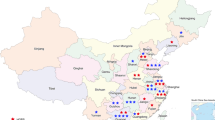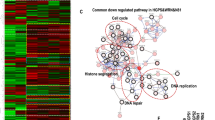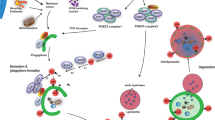Abstract
Hutchinson–Gilford progeria syndrome (HGPS) is a rare genetic disorder characterized by features reminiscent of marked premature ageing1,2. Here, we present evidence of mutations in lamin A (LMNA) as the cause of this disorder. The HGPS gene was initially localized to chromosome 1q by observing two cases of uniparental isodisomy of 1q—the inheritance of both copies of this material from one parent—and one case with a 6-megabase paternal interstitial deletion. Sequencing of LMNA, located in this interval and previously implicated in several other heritable disorders3,4, revealed that 18 out of 20 classical cases of HGPS harboured an identical de novo (that is, newly arisen and not inherited) single-base substitution, G608G(GGC > GGT), within exon 11. One additional case was identified with a different substitution within the same codon. Both of these mutations result in activation of a cryptic splice site within exon 11, resulting in production of a protein product that deletes 50 amino acids near the carboxy terminus. Immunofluorescence of HGPS fibroblasts with antibodies directed against lamin A revealed that many cells show visible abnormalities of the nuclear membrane. The discovery of the molecular basis of this disease may shed light on the general phenomenon of human ageing.
This is a preview of subscription content, access via your institution
Access options
Subscribe to this journal
Receive 51 print issues and online access
$199.00 per year
only $3.90 per issue
Buy this article
- Purchase on SpringerLink
- Instant access to full article PDF
Prices may be subject to local taxes which are calculated during checkout



Similar content being viewed by others
References
DeBusk, F. L. The Hutchinson-Gilford progeria syndrome. J. Pediat. 80, 697–724 (1972)
Baker, P. B., Baba, N. & Boesel, C. P. Cardiovascular abnormalities in progeria. Case report and review of the literature. Arch. Pathol. Lab. Med. 105, 384–386 (1981)
Burke, B. & Stewart, C. L. Life at the edge: the nuclear envelope and human disease. Nature Rev. 3, 575–585 (2002)
Genschel, J. & Schmidt, H.-J. Mutations in the LMNA gene encoding lamin A/C. Hum. Mutat. 16, 451–459 (2000)
Brown, W. T. Human mutations affecting aging—a review. Mech. Aging Dev. 9, 325–336 (1979)
Brown, W. T., Zebrowser, M. & Kieras, F. J. in Genetic Effects on Aging II (ed. Harrison, D. E.) 521–542 (Telford, Caldwell, New Jersey, 1990)
Trevas-Maciel, A. Evidence for autosomal recessive inheritance of progeria (Hutchinson Gilford). Am. J. Med. Genet. 31, 483–487 (1988)
Khalifa, M. M. Hutchinson-Gilford progeria syndrome: report of a Libyan family and evidence of autosomal recessive inheritance. Clin. Genet. 35, 125–132 (1989)
Lander, E. S. & Botstein, D. Homozygosity mapping: a way to map human recessive traits with the DNA of inbred children. Science 236, 1567–1570 (1987)
Brown, W. T. Progeria: a human disease model of accelerated aging. Am. J. Clin. Nutr. 55, 1222S–1224S (1992)
Fisher, D. Z., Chaudhary, N. & Blobel, G. cDNA sequencing of nuclear lamins A and C reveals primary and secondary structural homology to intermediate filament proteins. Proc. Natl Acad. Sci. USA 83, 6450–6454 (1986)
Lin, F. & Worman, H. J. Structural organization of the human gene encoding nuclear lamin A and nuclear lamin C. J. Biol. Chem. 268, 16321–16326 (1993)
Shiang, R. et al. Mutations in the transmembrane domain of FGFR3 cause the most common genetic form of dwarfism, achondroplasia. Cell 78, 335–342 (1994)
Smith, A. S., Wiznitzer, M., Karaman, B. A., Horwitz, S. J. & Lanzieri, C. F. MRA detection of vascular occusion in a child with progeria. Am. J. Neuroradiol. 14, 441–443 (1993)
Pulkkinen, L., Bullrich, F., Czarnecki, P., Weiss, L. & Uitto, J. Maternal uniparental disomy of chromosome 1 with reduction to homozygosity of the LAMB3 locus in a patient with Herlitz junctional epidermolysis bullosa. Am. J. Hum. Genet. 61, 611–619 (1997)
Gelb, B. D. et al. Paternal uniparental disomy for chromosome 1 revealed by molecular analysis of a patient with pycnodysostosis. Am. J. Hum. Genet. 62, 848–854 (1998)
Delgado-Luengo, W. et al. Del(1)(q23) in a patient with Hutchinson-Gilford progeria. Am. J. Med. Genet. 113, 298–301 (2002)
Lutz, R. J., Trujillo, M. A., Denham, K. S., Wenger, L. & Sinensky, M. Nucleoplasmic localization of prelamin A: implications for prenylation-dependent lamin A assembly into the nuclear lamina. Proc. Natl Acad. Sci. USA 89, 3000–3004 (1992)
Sinensky, M. et al. The processing pathway of prelamin A. J. Cell Sci. 107, 61–67 (1994)
Hennekes, H. & Nigg, E. A. The role of isoprenylation in membrane attachment of nuclear lamins, a single point mutation prevents the proteolytic cleavage of the lamin A precursor and confers membrane binding properties. J. Cell Sci. 107, 1019–1029 (1994)
Eggert, M. et al. Identification of novel phosphorylation sites in murine A-type lamins. Eur. J. Biochem. 213, 659–671 (1993)
Pendas, A. M. et al. Defective prelamin A processing and muscular and adipocyte alterations in Zmpste24 metalloproteinase-deficient mice. Nature Genet. 31, 94–99 (2002)
Bergo, M. O. et al. Zmpste24 deficiency in mice causes spontaneous bone fractures, muscle weakness, and a prelamin A processing defect. Proc. Natl Acad. Sci. USA 99, 13049–13054 (2002)
Sullivan, T. et al. Loss of A-type lamin expression compromises nuclear envelope integrity leading to muscular dystrophy. J. Cell Biol. 147, 913–920 (1999)
Smith, C. The detection of linkage in human genetics. J. R. Stat. Soc. B 15, 153–184 (1953)
Casper, A. M., Nghiem, P., Arlt, M. F. & Glover, T. W. ATR regulates fragile site stability. Cell 111, 779–789 (2002)
De Sandre-Giovannoli, A. et al. Homozygous defects in LMNA, encoding lamin A/C nuclear-envelope proteins, cause autosomal recessive axonal neuropathy in human (Charcot-Marie-Tooth disorder type 2) and mouse. Am. J. Hum. Genet. 70, 726–736 (2002)
Speckman, R. A. et al. Mutational and haplotype analyses of families with familial partial lipodystrophy (Dunnigan variety) reveal recurrent missense mutations in the globular C-terminal domain of lamin A/C. Am. J. Hum. Genet. 66, 1192–1198 (2000); erratum 67, 775 (2000)
Acknowledgements
We are grateful to all of the families with HGPS who donated blood and skin samples, without which this study would not have been possible. We would also like to express our gratitude to the entire Progeria Research Consortium, especially B. Toole, for their encouragement during the course of this work. We also thank E. Gillanders for providing the linkage marker set; P. Hollstein for assistance with genotyping; P. Chines for the identification of additional microsatellite markers on chromosome 1q; and M. Kirby for assistance with the flow cytometry. Support from the Progeria Research Foundation (L.B.G., M.W.G. and T.W.G.) and the Bedminster Foundation (W.T.B.) is gratefully acknowledged.
Author information
Authors and Affiliations
Corresponding author
Ethics declarations
Competing interests
The authors declare that they have no competing financial interests.
Supplementary information
Rights and permissions
About this article
Cite this article
Eriksson, M., Brown, W., Gordon, L. et al. Recurrent de novo point mutations in lamin A cause Hutchinson–Gilford progeria syndrome. Nature 423, 293–298 (2003). https://doi.org/10.1038/nature01629
Received:
Accepted:
Published:
Issue Date:
DOI: https://doi.org/10.1038/nature01629
This article is cited by
-
p300 nucleocytoplasmic shuttling underlies mTORC1 hyperactivation in Hutchinson–Gilford progeria syndrome
Nature Cell Biology (2024)
-
Epidemiological characteristics of patients with Hutchinson-Gilford progeria syndrome and progeroid laminopathies in China
Pediatric Research (2024)
-
Cellular reprogramming as a tool to model human aging in a dish
Nature Communications (2024)
-
Molecular hallmarks of ageing in amyotrophic lateral sclerosis
Cellular and Molecular Life Sciences (2024)
-
Loss-of-function variants affecting the STAGA complex component SUPT7L cause a developmental disorder with generalized lipodystrophy
Human Genetics (2024)



